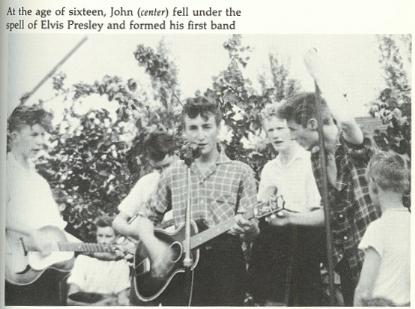
A Brief History of the Beatles:
From Their Humble Beginnings in Liverpool to the Birth of Beatlemania in America
by
Suzanne Smiley
May 1, 2000
"The British are coming! The British are coming!"
Indeed they were. The British were invading our poor little country. They crept into our homes and before we even knew what was happening... they had taken our children. There was nowhere to hide. Everywhere you turned they were there and there was absolutely nothing anyone could do to stop them. The only way to survive was to surrender to them... and buy their records.
I am talking, of course, not about the British Invasion in the early days of our fledgling country which sparked the Revolutionary War, but rather the British pop music invasion of 1964. Rock groups from overseas flooded onto the American scene like a crashing tidal wave, sporting such foreign sounding names as the Rolling Stones, the Who, the Kinks, the Troggs, Donovan, the Moody Blues, and Herman's Hermits. These, and many others, were all pioneered by a group -- whose name may have in some, stirred up images of a band of talented insects -- called the Beatles.
John, Paul, George, and Ringo: the four lads from Liverpool, England. By 1964, the Beatles were on top of the world, but they had come a long way from the four "moptops" that everyone the world over had grown to love.
There is some discrepancy on the early origins of the Beatles. I have examined many different sources all widely ranging on their claim of what "really" happened. The reason is simple. Do you remember everything about when and where you were at age sixteen? With that in mind, I have tried to piece together what I hope is a fairly accurate version of the Beatles' early history.
Greatly influenced by rock legend Elvis Presley, John Lennon started his first band called the Quarrymen in 1956 at the age of sixteen (Schaffner 12). On July 6, 1957 John Lennon would meet Paul McCartney for the first time. One of John's bandmates, Ivan Vaughan, also a friend of fifteen year old Paul McCartney, invited Paul to the St. Peter's Church garden fete in Woolton, Liverpool where the Quarrymen would be playing. Paul actually went, not to hear the band perform, but rather because Ivan had convinced him that the church picnic would be a great place to pick up girls (Brown and Gaines 21). Paul listened faintly to the Quarrymen play, but noticed that the band's leader was singing the wrong words to "Come Go With Me". Later that afternoon, as the boys were hanging out together, Paul was officially introduced to John. Paul borrowed a guitar from one of the boys and began to show off a bit. He played complicated chords that the others didn't know which he had learned simply from picking them out from the radio. He offered to write down the words to "Twenty Flight Rock" and "Be Bop a Lula" so that John could learn them (Brown and Gaines 22). John was genuinely impressed with Paul, not only because he could play so well but because he could tune a guitar, a feat that the others had not yet mastered. A few days later while riding his bicycle, Paul ran into Pete Shotton, one of the Quarrymen. Pete told Paul that they had talked it over and John wanted Paul to join the band. After a moment's contemplation, Paul replied "Oh, all right" (Goldman 72).

John and Paul became friends, writing songs together. They complemented each other perfectly. John's words and music had a raw, explosive energy. Paul possessed more polish and melodic grace. Often one of them would write the bulk of the song, and the other would contribute the "middle eight" or the bridge. Their different styles gave the middle eight a real contrast to the main theme (Celsi 16).
Ivan Vaughan had introduced Paul McCartney to the Quarrymen and Paul, in turn, would introduce George Harrison. Paul and George lived near each other and would often sit together on the bus to school. Although Paul was over eight months older than George -- which seemed like quite an age difference at the time -- the boys soon learned that they had similar interests in rock 'n' roll and guitars (The Beatles Anthology). Paul discovered that the fourteen year old knew dozens more chords than he and John put together (Giuliano 28). George could also pick out actual solos instead of merely strumming (Goldman 75). Paul thought George would be an excellent addition to the Quarrymen. John, however, did not. The seventeen year old thought that George was too young and would ruin the band's "tough guy" image (Giuliano 28). In early February, 1958, Paul finally convinced a skeptical John to hear George play. John had been astonished with the young guitarist's perfect rendition of the eight note bass tune, "Ranchee" (Miles 47), but still looked at George as a kid and refused to take him seriously (Goldman 75). This didn't deter George, however who came to idolize John, doing everything he could to emulate him. He tagged along after John and the group, hoping that one day he would be asked to play with them. He went to all of their shows where he stood in the back with his guitar. A few times when one of the regular guitarists failed to show up, George was allowed to sit in with the band, and on rare occasions he even got to do his own, breath-holding solo. Eventually, before anybody noticed what was happening, he became a member of the group (Brown and Gaines 31).
The Quarrymen evolved into Johnny and the Moondogs, then into Long John and the Silver Beetles and then finally, into the Beatles (Celsi 16). One of John's rock 'n' roll heroes was Buddy Holly whose band was called the Crickets so John tried to dream up an insect name of his own. The result was "Beetles", but unable to resist the pun, he changed "Beet" to "Beat". Explained John, "When you said it, people thought of crawly things, when you read it it was beat music" (Schaffner 19).
Members were added and thrown out of the group eventually leaving only John, Paul, and George. The three guitarists began a long search for a bass player and a drummer. John finally persuaded his best friend from art college, Stuart Sutcliffe, to buy a bass and join the band (Schaffner 18). Unfortunately for the group, Stu was a much more talented painter than a bass player. But according to John, "It was better to have a bass player who couldn't play than to not have a bass player at all" (The Beatles Anthology).
At this time, there was little to set the Beatles apart from dozens of other teenage groups playing in Liverpool's cellar cafes (Schaffner 19). Their first big break came in August 1960 when a local club owner and band recruiter, Allan Williams, told the Beatles about a gig in Hamburg, Germany. The job was theirs under the condition that they become a five piece band (The Beatles Anthology). This left the Beatles scrambling to find a drummer. John recalls, "We had all sorts of drummers at the time because people who owned drum kits were few and far between; it was an expensive item. They were usually idiots. We got Pete Best because we needed a drummer the next day to go to Hamburg" (The Beatles Anthology).

American rock 'n' roll had grown to be very popular in Germany and it was easier to bring in English bands than to get acts all the way from the United States. Playing in the clubs under poor working conditions with little pay, among the sleazy bars and strip clubs of Hamburg, Germany was where the Beatles got their first real taste of fame (Schaffner 19). Here Stu met and fell for a young, pretty photographer named Astrid Kirchherr. Hamburg was also where the Beatles met another Liverpool band by the name of Rory Storme and the Hurricanes whose drummer at the time was Ringo Starr. Ringo, whose real name was Richard Starkey, was only a few months older than John. He got the name "Ringo" for the many rings he wore on his fingers. His last name was shortened to "Starr" so that the drum solos he did with Rory and the Hurricanes could be called "Ringo's Starr Time".
The Beatles' first trip to Germany was short lived, however. In November 1960, a brief scrape with the law involving a nightclub prank resulted in Pete and Paul getting jailed for a night and sent back to England the next morning. Soon after, it was discovered that George was only seventeen, a year younger than the minimum age for nightclub performers. He was sent home as well. Drifting back home to Liverpool, the boys felt dejected and beaten, oblivious to the vast improvement playing in such miserable isolation had made to their music (Giuliano 46).
After George turned eighteen, the Beatles made a second trip to Germany in March 1961. The undisputed highlight of this second trip was that the group made their first professional record on June 22, 1961, backing Tony Sheridan's "My Bonnie" (Giuliano 55). By this time Stu had decided to leave the band in order to further pursue his painting and his relationship with Astrid so it was Paul who took over bass guitar for this recording session and there after. Also, during this trip, the Beatles were becoming aware of the hairstyles worn by some of the German art students they had met there. Stu had been the first to copy this haircut, Astrid styling it for him. Later, the others slowly adapted it (all except Pete), taking elements of it and making it their own. Thus the "Beatle hairstyle" was born (Miles 76).
The Beatles second trip to Hamburg ended July 2, 1961. They left for Liverpool and continued to play at their regular hometown hangout, the Cavern Club. In October 1961 several people in only a few days time entered Brian Epstein's record store in Liverpool asking for a record called "My Bonnie" by the Beatles. This wasn't the first Epstein had heard of the group, who were already quite a popular subject in the pages of the local music paper, the "Mersey Beat". Still, Epstein's curiosity was aroused and he decided to check out the Beatles in person. The Beatles didn't strike Epstein as very good musicians, but he liked their charisma. He went back to the Cavern several times to hear the Beatles play before announcing to the group that he'd like to become their manager.
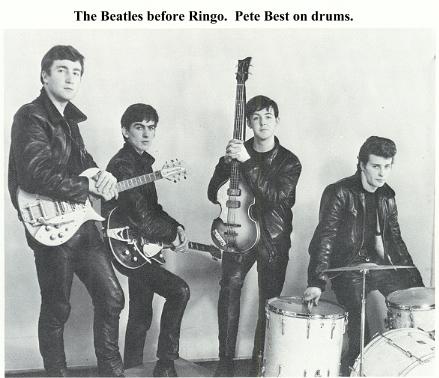
On January 24, 1962, the Beatles signed a management contract with Brian Epstein. It was also this month in which the Beatles made a demo tape that Epstein shopped around to all the record companies. All turned him down except for Parlophone Records, which had never before made a rock 'n' roll record. The Beatles met with Parlophone's producer, George Martin who was more amused with their humor than their music and decided to give them a chance.
"Let me know if there's anything you don't like," said Martin kindly as he showed the Beatles around the studio.
"Well, for starters," George quipped, "I don't like your tie."
Before the Beatles were scheduled to record their first single for Parlophone, John, Paul, and George gave Brian Epstein the dirty work of getting rid of Pete Best. Pete had become somewhat unreliable and his drumming had never been very good. The Beatles felt they would be better with Ringo Starr, who had sat in with them on numerous occasions when Pete failed to show. It wasn't easy for Ringo coming into the group. Especially since the Beatles' careers had just begun to really take off. Best had a whole contingent of fans who protested until Ringo's playing convinced them that the change was for the better. Then Ringo had to win over Beatles' producer George Martin. On September 11, 1962, at their first recording session, Martin brought in a studio drummer and gave Ringo a tambourine to shake. Only when he saw how dejected Ringo looked did Martin allow him to play and then discovered how good he was (Celsi 62).
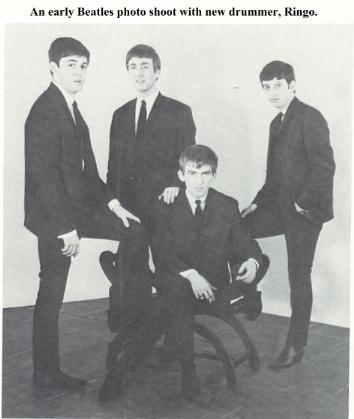
The Beatles released their first single, "Love Me Do", on October 5, 1962. It eventually reached number seventeen on Britain's national best-seller chart (Schaffner 23). Meanwhile, Brian Epstein worked hard on improving the Beatles' image. He forced the rough, rugged band to tame their rebellious image, made them wear suits on stage and stopped them from drinking and swearing... at least during their act (Celsi 17). The Beatles soon plunged into a nonstop series of national tours. Their second single, "Please Please Me" released in January 1963, hit number one in only five weeks. The Beatles first album, "Please Please Me", recorded on February 1963, remained Britain's number one album for thirty weeks before another Beatles album took its place (Schaffner 26). "From Me To You", the Beatles' third single, raced to the top of the British charts, but it was "She Loves You" which made the biggest impact yet. It became the biggest selling record ever to be released in Britain -- never topped until 1977, by one of Paul McCartney's own tunes (Schaffner 26).
The Beatles had taken Europe, and seemingly most of the world, by storm, but there was one place which had yet to discover Beatlemania... America. No other British rock 'n' roll band ever made it big in America. Therefore, the Beatles decided they would not go to America until they had a number one single there. The trouble was, no major record company would pick up the Beatles' hits which had been so big in Britain. Released under small labels, nobody ever heard them. It wasn't until Capitol Records picked up their fifth single, "I Want To Hold Your Hand", in January 1964, that the Beatles had their first number one song in America (The Beatles Anthology). After that, the first four previous flops sprang to life and also shot up the American charts.
On February 7, 1964, the Beatles arrived at Kennedy Airport in New York City to hundreds of screaming fans. The Beatles were in awe. "So this is America," said Ringo in the midst of it all, "They all seem out of their minds" (Davis 42). On February 9, the Beatles made their first appearance on the "Ed Sullivan Show". If anybody in the United States didn't know who the Beatles were before, they did after that night. By April 4, 1964, the top five hits on Billboard's best-selling singles chart were all held by the Beatles. That same week, the Beatles were number one and number two on the LP charts as well (Schaffner 44). Beatlemania had finally hit America. The pilgrims of the British Invasion were here to stay.
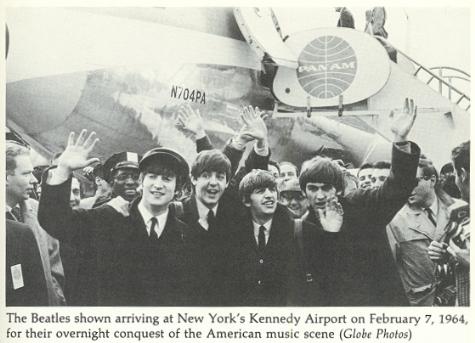
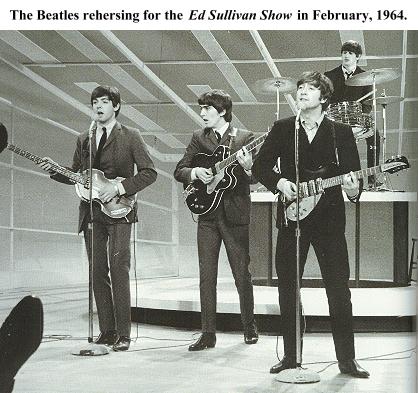
Brown, Peter, and Steven Gaines. The Love You Make: An Insider's Story of the Beatles. New York: Signet, 1983.
Celsi, Theresa. The Beatles. Kansas City: Ariel Books, 1993.
Davis, Andy. The Beatles Files. New York: CLB, 1998.
Giuliano, Geoffrey. Blackbird: The Life and Times of Paul McCartney. 1991. Toronto: Da Capo Press, 1997.
Goldman, Albert. The Lives of John Lennon. 1988. New York: Bantam Books, 1989.
Miles, Barry. Paul McCartney: Many Years From Now. New York: Henry Holt and Company, 1997.
Schaffner, Nicholas. The Boys From Liverpool: John, Paul, George, Ringo. New York: Methuen, 1980.
The Beatles Anthology. Dir. Geoff Wonfor. Perf. John Lennon, Paul McCartney, George Harrison, and Ringo Starr. Capitol Video, 1996.
